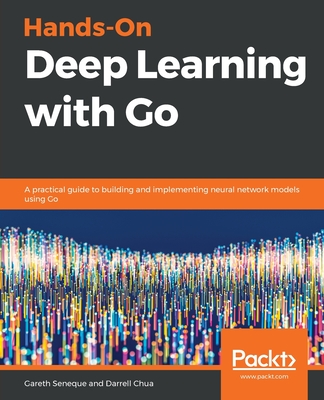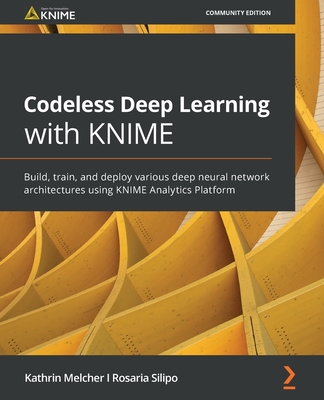Introduction to Deep Learning: From Logical Calculus to Artificial Intelligence (Undergraduate Topics in Computer Science)
暫譯: 深度學習導論:從邏輯演算到人工智慧(計算機科學本科主題)
Sandro Skansi
- 出版商: Springer
- 出版日期: 2018-02-15
- 售價: $1,980
- 貴賓價: 9.5 折 $1,881
- 語言: 英文
- 頁數: 191
- 裝訂: Paperback
- ISBN: 3319730037
- ISBN-13: 9783319730035
-
相關分類:
DeepLearning
-
相關翻譯:
深入淺出深度學習 (簡中版)
立即出貨
買這商品的人也買了...
-
 $299Python Power!: The Comprehensive Guide
$299Python Power!: The Comprehensive Guide -
 Secure Coding in C and C++, 2/e (Paperback)
Secure Coding in C and C++, 2/e (Paperback)$2,430$2,309 -
 $840Interactive Data Visualization for the Web (Paperback)
$840Interactive Data Visualization for the Web (Paperback) -
 The CERT C Coding Standard: 98 Rules for Developing Safe, Reliable, and Secure Systems, 2/e (Paperback)
The CERT C Coding Standard: 98 Rules for Developing Safe, Reliable, and Secure Systems, 2/e (Paperback)$1,800$1,764 -
 $1,045Doing Math with Python: Use Programming to Explore Algebra, Statistics, Calculus, and More! (Paperback)
$1,045Doing Math with Python: Use Programming to Explore Algebra, Statistics, Calculus, and More! (Paperback) -
 OpenGL Superbible: Comprehensive Tutorial and Reference, 7/e (Paperback)
OpenGL Superbible: Comprehensive Tutorial and Reference, 7/e (Paperback)$2,400$2,280 -
 $594Xcode 實戰:Apple 平臺開發實用技術、技巧及最佳流程
$594Xcode 實戰:Apple 平臺開發實用技術、技巧及最佳流程 -
 $1,155Data Visualization with Python and JavaScript: Scrape, Clean, Explore & Transform Your Data
$1,155Data Visualization with Python and JavaScript: Scrape, Clean, Explore & Transform Your Data -
 Advanced Machine Learning with Python (Paperback)
Advanced Machine Learning with Python (Paperback)$1,810$1,720 -
 A First Course in Machine Learning, 2/e (Hardcover)
A First Course in Machine Learning, 2/e (Hardcover)$2,980$2,831 -
 $1,169The Hitchhiker's Guide to Python: Best Practices for Development (Paperback)
$1,169The Hitchhiker's Guide to Python: Best Practices for Development (Paperback) -
 Invent Your Own Computer Games with Python, 4/e (Paperback)
Invent Your Own Computer Games with Python, 4/e (Paperback)$990$941 -
 Deep Learning (Hardcover)
Deep Learning (Hardcover)$1,650$1,617 -
 Bayesian Analysis with Python
Bayesian Analysis with Python$1,990$1,891 -
深度學習快速入門 — 使用 TensorFlow (Getting started with TensorFlow)
$360$281 -
 $2,538Deep Learning for Medical Image Analysis
$2,538Deep Learning for Medical Image Analysis -
 $948Swift Programming: The Big Nerd Ranch Guide, 2/e (Paperback)
$948Swift Programming: The Big Nerd Ranch Guide, 2/e (Paperback) -
 $749Fundamentals of Deep Learning: Designing Next-Generation Machine Intelligence Algorithms (Paperback)
$749Fundamentals of Deep Learning: Designing Next-Generation Machine Intelligence Algorithms (Paperback) -
 寫程式前就該懂的演算法 ─ 資料分析與程式設計人員必學的邏輯思考術 (Grokking Algorithms: An illustrated guide for programmers and other curious people)
寫程式前就該懂的演算法 ─ 資料分析與程式設計人員必學的邏輯思考術 (Grokking Algorithms: An illustrated guide for programmers and other curious people)$390$308 -
 Deep Learning|用 Python 進行深度學習的基礎理論實作
Deep Learning|用 Python 進行深度學習的基礎理論實作$580$458 -
 Deep Learning with Python (Paperback)
Deep Learning with Python (Paperback)$1,800$1,710 -
 $1,840Pro Deep Learning with TensorFlow: A Mathematical Approach to Advanced Artificial Intelligence in Python
$1,840Pro Deep Learning with TensorFlow: A Mathematical Approach to Advanced Artificial Intelligence in Python -
 Python 機器學習, 2/e (Python Machine Learning, 2/e)
Python 機器學習, 2/e (Python Machine Learning, 2/e)$690$538 -
 The Sentient Machine: The Coming Age of Artificial Intelligence
The Sentient Machine: The Coming Age of Artificial Intelligence$1,180$1,121 -
 Deep Learning with Python (Amazon)
Deep Learning with Python (Amazon)$1,650$1,617
相關主題
商品描述
This textbook presents a concise, accessible and engaging first introduction to deep learning, offering a wide range of connectionist models which represent the current state-of-the-art. The text explores the most popular algorithms and architectures in a simple and intuitive style, explaining the mathematical derivations in a step-by-step manner. The content coverage includes convolutional networks, LSTMs, Word2vec, RBMs, DBNs, neural Turing machines, memory networks and autoencoders. Numerous examples in working Python code are provided throughout the book, and the code is also supplied separately at an accompanying website.
Topics and features: introduces the fundamentals of machine learning, and the mathematical and computational prerequisites for deep learning; discusses feed-forward neural networks, and explores the modifications to these which can be applied to any neural network; examines convolutional neural networks, and the recurrent connections to a feed-forward neural network; describes the notion of distributed representations, the concept of the autoencoder, and the ideas behind language processing with deep learning; presents a brief history of artificial intelligence and neural networks, and reviews interesting open research problems in deep learning and connectionism.
This clearly written and lively primer on deep learning is essential reading for graduate and advanced undergraduate students of computer science, cognitive science and mathematics, as well as fields such as linguistics, logic, philosophy, and psychology.
商品描述(中文翻譯)
這本教科書提供了一個簡明、易懂且引人入勝的深度學習入門介紹,涵蓋了多種代表當前最先進技術的連結主義模型。文本以簡單直觀的風格探討最受歡迎的演算法和架構,並逐步解釋數學推導。內容涵蓋卷積網路(convolutional networks)、長短期記憶網路(LSTMs)、Word2vec、限制玻爾茲曼機(RBMs)、深度信念網路(DBNs)、神經圖靈機(neural Turing machines)、記憶網路(memory networks)和自編碼器(autoencoders)。書中提供了大量的 Python 實作範例,相關的程式碼也可在附屬網站上單獨獲得。
主題與特點:介紹機器學習的基本原理,以及深度學習所需的數學和計算前提;討論前饋神經網路(feed-forward neural networks),並探討可應用於任何神經網路的修改;檢視卷積神經網路(convolutional neural networks)及其與前饋神經網路的遞迴連結;描述分散表示(distributed representations)的概念、自編碼器的概念,以及深度學習在語言處理中的理念;簡要回顧人工智慧和神經網路的歷史,並回顧深度學習和連結主義中的有趣開放研究問題。
這本清晰且生動的深度學習入門書籍是計算機科學、認知科學和數學的研究生及高年級本科生,以及語言學、邏輯學、哲學和心理學等領域的學生必讀的書籍。
































